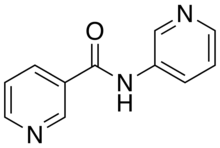3-Pyridylnicotinamide
 From Wikipedia the free encyclopedia
From Wikipedia the free encyclopedia
 | |
| Names | |
|---|---|
| Preferred IUPAC name N-(Pyridin-3-yl)pyridine-3-carboxamide | |
| Other names 3-pna 3-pyridinecarboxamide, N-3-pyridinyl- N-(Pyridin-3-yl)nicotinamide | |
| Identifiers | |
3D model (JSmol) | |
| ChEMBL | |
| ChemSpider | |
PubChem CID | |
| UNII | |
CompTox Dashboard (EPA) | |
| |
| |
| Properties | |
| C11H9N3O | |
| Molar mass | 199.20 g/mol |
| Density | 1.287 g/cm3 |
| Boiling point | 286.08 °C (546.94 °F; 559.23 K) |
| Structure | |
| 0 D | |
| Hazards | |
| Flash point | 127 °C (261 °F; 400 K) |
| Related compounds | |
Related compounds | 4,4'-bipyridine Pyridine Nicotinamide 3-Aminopyridine 4-Pyridylnicotinamide |
Except where otherwise noted, data are given for materials in their standard state (at 25 °C [77 °F], 100 kPa). | |
The organic compound 3-pyridylnicotinamide (3-pna), also known as N-(pyridin-3-yl)nicotinamide, is a kinked dipodal dipyridine that is synthesized through the reaction of nicotinoyl chloride and 3-aminopyridine.[1] The nitrogen atoms on its pyridine rings, like those of its isomer 4-pyridylnicotinamide, can donate their electron lone pairs to metal cations, allowing it to bridge metal centers and act as a bidentate ligand in coordination polymers.[2][3][4][5][6] It can be used to synthesize polymers that have potentially useful gas adsorption properties.[2][3]
References[edit]
- ^ Zheng, X.; Salgia, S. R.; Thompson, W. B.; Dillingham, E. O.; Bond, S. E.; Feng, Z.; Prasad, K. R.; Gollamudi, R. (1995). "Design and Synthesis of Piperidine-3-carboxamides as Human Platelet Aggregation Inhibitors". Journal of Medicinal Chemistry. 38 (1): 180–188. doi:10.1021/jm00001a023. PMID 7837229.
- ^ a b Uemura, K.; Kitagawa, S.; Fukui, K. I.; Saito, K. (2004). "A Contrivance for a Dynamic Porous Framework: Cooperative Guest Adsorption Based on Square Grids Connected by Amide−Amide Hydrogen Bonds". Journal of the American Chemical Society. 126 (12): 3817–3828. doi:10.1021/ja039914m. PMID 15038736.
- ^ a b Uemura, K.; Kitagawa, S.; Kondo, M.; Fukui, K. I.; Kitaura, R.; Chang, H. C.; Mizutani, T. (2002). "Novel Flexible Frameworks of Porous Cobalt(II) Coordination Polymers That Show Selective Guest Adsorption Based on the Switching of Hydrogen-Bond Pairs of Amide Groups". Chemistry: A European Journal. 8 (16): 3586–4100. doi:10.1002/1521-3765(20020816)8:16<3586::AID-CHEM3586>3.0.CO;2-K. PMID 12203285.
- ^ Kumar, D. K.; Das, A.; Dastidar, P. (2007). "Supramolecular structural diversities in the metal?organic frameworks derived from pyridylamide ligands: Studying the effects of ligating topologies, hydrogen bonding backbone of the ligands and counter anions". CrystEngComm. 9 (7): 548. doi:10.1039/B701782K.
- ^ Banerjee, S.; Adarsh, N. N.; Dastidar, P. (2010). "Selective Separation of the Sulfate Anion by in Situ Crystallization of CdII Coordination Compounds Derived from Bis(pyridyl) Ligands Equipped with a Urea/Amide Hydrogen-Bonding Backbone". European Journal of Inorganic Chemistry. 2010 (24): 3770. doi:10.1002/ejic.201000359.
- ^ Kumar, D. K.; Das, A.; Dastidar, P. (2007). "Conformation dependent network structures in the coordination polymers derived from pyridylisonicotinamides, carboxylates and Co(ii): Entrapment of (H2O)14 water cluster of an unprecedented topology". CrystEngComm. 9 (10). Royal Society of Chemistry: 895. doi:10.1039/B705851A.